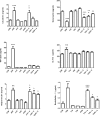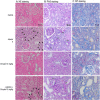Ameliorative effect of chrysin on adenine-induced chronic kidney disease in rats
- PMID: 25909514
- PMCID: PMC4409384
- DOI: 10.1371/journal.pone.0125285
Ameliorative effect of chrysin on adenine-induced chronic kidney disease in rats
Abstract
Chrysin (5, 7- dihydroxyflavone) is a flavonoid with several pharmacological properties that include antioxidant, anti-inflammatory and antiapoptotic activities. in this work, we investigated some effects of three graded oral doses of chrysin (10, 50 and 250 mg/kg) on kidney structure and function in rats with experimental chronic renal disease (CKD) induced by adenine (0.25% w/w in feed for 35 days), which is known to involve inflammation and oxidative stress. Using several indices in plasma, urine and kidney homogenates, adenine was found to impair kidney function as it lowered creatinine clearance and increased plasma concentrations of creatinine, urea, neutrophil gelatinase-associated lipocalin and N-Acetyl-beta-D-glucosaminidase activity. Furthermore, it raised plasma concentrations of the uremic toxin indoxyl sulfate, some inflammatory cytokines and urinary albumin concentration. Renal morphology was severely damaged and histopathological markers of inflammation and fibrosis were especially increased. In renal homogenates, antioxidant indices, including superoxide dismutase and catalase activities, total antioxidant capacity and reduced glutathione were all adversely affected. Most of these adenine - induced actions were moderately and dose -dependently mitigated by chrysin, especially at the highest dose. Chrysin did not cause any overt adverse effect on the treated rats. The results suggest that different doses of chrysin produce variable salutary effects against adenine-induced CKD in rats, and that, pending further pharmacological and toxicological studies, its usability as a possible ameliorative agent in human CKD should be considered.
Conflict of interest statement
Figures







Similar articles
-
Therapeutic Effect of Chrysin on Adenine-Induced Chronic Kidney Disease in Rats.Cell Physiol Biochem. 2016;38(1):248-57. doi: 10.1159/000438626. Epub 2016 Jan 20. Cell Physiol Biochem. 2016. PMID: 26784294
-
Curcumin Ameliorates Kidney Function and Oxidative Stress in Experimental Chronic Kidney Disease.Basic Clin Pharmacol Toxicol. 2018 Jan;122(1):65-73. doi: 10.1111/bcpt.12817. Epub 2017 Jul 10. Basic Clin Pharmacol Toxicol. 2018. PMID: 28561324
-
The effect of sildenafil on rats with adenine-Induced chronic kidney disease.Biomed Pharmacother. 2018 Dec;108:391-402. doi: 10.1016/j.biopha.2018.09.061. Epub 2018 Sep 17. Biomed Pharmacother. 2018. PMID: 30236848
-
A comprehensive review on hepatoprotective and nephroprotective activities of chrysin against various drugs and toxic agents.Chem Biol Interact. 2019 Aug 1;308:51-60. doi: 10.1016/j.cbi.2019.05.010. Epub 2019 May 11. Chem Biol Interact. 2019. PMID: 31085170 Review.
-
Flavonoids in Treatment of Chronic Kidney Disease.Molecules. 2022 Apr 6;27(7):2365. doi: 10.3390/molecules27072365. Molecules. 2022. PMID: 35408760 Free PMC article. Review.
Cited by
-
Chrysin for Neurotrophic and Neurotransmitter Balance in Parkinson's Disease.Methods Mol Biol. 2024;2761:477-490. doi: 10.1007/978-1-0716-3662-6_32. Methods Mol Biol. 2024. PMID: 38427256
-
Metabolomic and biochemical characterization of a new model of the transition of acute kidney injury to chronic kidney disease induced by folic acid.PeerJ. 2019 Jun 21;7:e7113. doi: 10.7717/peerj.7113. eCollection 2019. PeerJ. 2019. PMID: 31275747 Free PMC article.
-
Dietary Fermented Soy Extract and Oligo-Lactic Acid Alleviate Chronic Kidney Disease in Mice via Inhibition of Inflammation and Modulation of Gut Microbiota.Nutrients. 2020 Aug 8;12(8):2376. doi: 10.3390/nu12082376. Nutrients. 2020. PMID: 32784477 Free PMC article.
-
Catalpol Attenuates Oxidative Stress and Inflammation via Mechanisms Involving Sirtuin-1 Activation and NF-κB Inhibition in Experimentally-Induced Chronic Kidney Disease.Nutrients. 2023 Jan 3;15(1):237. doi: 10.3390/nu15010237. Nutrients. 2023. PMID: 36615896 Free PMC article.
-
Renoprotective Effect of Chrysanthemum coronarium L. Extract on Adenine-Induced Chronic Kidney Disease in Mice.Pharmaceuticals (Basel). 2023 Jul 24;16(7):1048. doi: 10.3390/ph16071048. Pharmaceuticals (Basel). 2023. PMID: 37513959 Free PMC article.
References
Publication types
MeSH terms
Substances
LinkOut - more resources
Full Text Sources
Other Literature Sources
Medical

